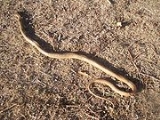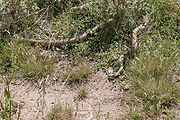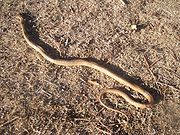
Pseudonaja
Encyclopedia
Pseudonaja is a genus
of venomous elapid snake
s native to Australia
. Members are known commonly as brown snakes and are considered to be one of the most dangerous snakes in the country; even young snakes are capable of delivering a fatal envenomation
to a human.

 Brown snakes are easily alarmed and may bite if approached closely, handled or threatened. Less than half of bites contain venom
Brown snakes are easily alarmed and may bite if approached closely, handled or threatened. Less than half of bites contain venom
and there are minimal effects at the bite site. Sudden, early collapse is often a feature of brown snake envenomation. A prominent effect of envenomation is venom-induced consumption coagulopathy
and this can lead to death. Renal damage may also rarely occur.
Other clinical signs include: abdominal pain, breathing and swallowing difficulty, convulsions, ptosis
, hemolysis
, hypotension from depression of myocardial contractility, renal failure. Notably rhabdomyolysis
is not a feature of envenomation by brown snakes.
The Eastern Brown Snake (Pseudonaja textilis) is the most toxic member of the genus and is considered by some to be the second most toxic land snake in the world, after the Inland Taipan (which is also found in Australia). The western brown snake is the tenth most venomous snake in the world.
Brown snakes can easily harm animals and live stock as well.
Genus
In biology, a genus is a low-level taxonomic rank used in the biological classification of living and fossil organisms, which is an example of definition by genus and differentia...
of venomous elapid snake
Snake
Snakes are elongate, legless, carnivorous reptiles of the suborder Serpentes that can be distinguished from legless lizards by their lack of eyelids and external ears. Like all squamates, snakes are ectothermic, amniote vertebrates covered in overlapping scales...
s native to Australia
Australia
Australia , officially the Commonwealth of Australia, is a country in the Southern Hemisphere comprising the mainland of the Australian continent, the island of Tasmania, and numerous smaller islands in the Indian and Pacific Oceans. It is the world's sixth-largest country by total area...
. Members are known commonly as brown snakes and are considered to be one of the most dangerous snakes in the country; even young snakes are capable of delivering a fatal envenomation
Envenomation
Envenomation is the process by which venom is injected into some animal by the bite of a venomous animal. Many kinds of animals, including mammals , reptiles , spiders , insects , employ venom for hunting and for self defense...
to a human.
Species
- DugiteDugiteDugite is a common name for the highly venomous snake, Pseudonaja affinis, an Australian species which can inflict a fatal bite.-Description:...
or Spotted Brown Snake , Pseudonaja affinis- Pseudonaja affinis affinis (GüntherAlbert C. L. G. GüntherAlbert Karl Ludwig Gotthilf Günther FRS, also Albert Charles Lewis Gotthilf Günther , was a German-born British zoologist, ichthyologist, and herpetologist....
, 1872) — coastal mainland Western AustraliaWestern AustraliaWestern Australia is a state of Australia, occupying the entire western third of the Australian continent. It is bounded by the Indian Ocean to the north and west, the Great Australian Bight and Indian Ocean to the south, the Northern Territory to the north-east and South Australia to the south-east...
. - Pseudonaja affinis exilis (Storr, 1989) — mainland Western Australia and Rottnest IslandRottnest IslandRottnest Island is located off the coast of Western Australia, near Fremantle. It is called Wadjemup by the Noongar people, meaning "place across the water". The island is long, and at its widest point with a total land area of . It is classified as an A Class Reserve and is managed by the...
. - Pseudonaja affinis tanneri (Worrell, 1961) — mainland Western Australia, Boxer Island and other islands.
- Pseudonaja affinis affinis (Günther
- Speckled Brown Snake or Spotted Brown Snake , Pseudonaja guttata (Parker, 1926) — Northern TerritoryNorthern TerritoryThe Northern Territory is a federal territory of Australia, occupying much of the centre of the mainland continent, as well as the central northern regions...
, QueenslandQueenslandQueensland is a state of Australia, occupying the north-eastern section of the mainland continent. It is bordered by the Northern Territory, South Australia and New South Wales to the west, south-west and south respectively. To the east, Queensland is bordered by the Coral Sea and Pacific Ocean...
, and South AustraliaSouth AustraliaSouth Australia is a state of Australia in the southern central part of the country. It covers some of the most arid parts of the continent; with a total land area of , it is the fourth largest of Australia's six states and two territories.South Australia shares borders with all of the mainland...
. - Peninsula Brown Snake, Pseudonaja inframacula (Waite, 1925) — South Australia, Western Australia, Eyre PeninsulaEyre PeninsulaEyre Peninsula is a triangular peninsula in South Australia. It is bounded on the east by Spencer Gulf, the west by the Great Australian Bight, and the north by the Gawler Ranges. It is named after explorer Edward John Eyre who explored some of it in 1839-1841. The coastline was first explored by...
. - Ingram's Brown Snake, Pseudonaja ingrami (BoulengerGeorge Albert BoulengerGeorge Albert Boulenger FRS was a Belgian-British zoologist who identified over 2000 new animal species, chiefly fish, reptiles and amphibians.-Life:...
, 1908) — Northern Territory, Queensland, and Western AustraliaWestern AustraliaWestern Australia is a state of Australia, occupying the entire western third of the Australian continent. It is bounded by the Indian Ocean to the north and west, the Great Australian Bight and Indian Ocean to the south, the Northern Territory to the north-east and South Australia to the south-east...
. - Ringed Brown Snake, Pseudonaja modesta (GüntherAlbert C. L. G. GüntherAlbert Karl Ludwig Gotthilf Günther FRS, also Albert Charles Lewis Gotthilf Günther , was a German-born British zoologist, ichthyologist, and herpetologist....
, 1872) — New South Wales, Northern Territory, Queensland, South Australia, and Western Australia. - Gwardar or Western Brown Snake, Pseudonaja nuchalisPseudonaja nuchalisThe Western Brown snake, or Gwarder, is a very fast, highly venomous snake native to Australia. Its colour and pattern is rather variable, depending largely on its location. It is most closely related to the Spotted Brown Snake, Speckled Brown Snake, Peninsula Brown Snake, Ingram's Brown Snake,...
(GüntherAlbert C. L. G. GüntherAlbert Karl Ludwig Gotthilf Günther FRS, also Albert Charles Lewis Gotthilf Günther , was a German-born British zoologist, ichthyologist, and herpetologist....
, 1858) — New South Wales, Northern Territory, Queensland, South Australia, VictoriaVictoria (Australia)Victoria is the second most populous state in Australia. Geographically the smallest mainland state, Victoria is bordered by New South Wales, South Australia, and Tasmania on Boundary Islet to the north, west and south respectively....
, and Western Australia. - Eastern Brown Snake, Pseudonaja textilis (DumérilAndré Marie Constant DumérilAndré Marie Constant Duméril was a French zoologist. He was professor of anatomy at the Muséum National d'Histoire Naturelle from 1801 to 1812, when he became professor of herpetology and ichthyology...
, BibronGabriel BibronGabriel Bibron was a French zoologist. He was born in Paris. Son of an employee of the Museum national d'histoire naturelle, he had a good foundation in natural history and was hired to collect vertebrates in Italy and Sicily. He classified a number of reptile species with André Marie Constant...
& DumérilAuguste DumérilAuguste Henri André Duméril was a French zoologist. He was professor of Herpetology and Ichthyology at the Muséum National d'Histoire Naturelle in Paris from 1857. His father André Marie Constant Duméril was also a zoologist...
, 1854) — New South Wales, Northern Territory, QueenslandQueenslandQueensland is a state of Australia, occupying the north-eastern section of the mainland continent. It is bordered by the Northern Territory, South Australia and New South Wales to the west, south-west and south respectively. To the east, Queensland is bordered by the Coral Sea and Pacific Ocean...
, South Australia, Victoria, Western Australia, south-eastern West Papua, and both south-eastern (Central Province) and north-eastern (Oro & Milne Bay Provinces) Papua New GuineaPapua New GuineaPapua New Guinea , officially the Independent State of Papua New Guinea, is a country in Oceania, occupying the eastern half of the island of New Guinea and numerous offshore islands...
.

Toxicity

Venom
Venom is the general term referring to any variety of toxins used by certain types of animals that inject it into their victims by the means of a bite or a sting...
and there are minimal effects at the bite site. Sudden, early collapse is often a feature of brown snake envenomation. A prominent effect of envenomation is venom-induced consumption coagulopathy
Venom-induced consumption coagulopathy
Venom-induced consumption coagulopathy is a medical condition caused by the effects of some snake venoms on hemostasis. Important coagulation factors are activated by the specific toxins, and as they become exhausted coagulopathy develops....
and this can lead to death. Renal damage may also rarely occur.
Other clinical signs include: abdominal pain, breathing and swallowing difficulty, convulsions, ptosis
Ptosis (eyelid)
Ptosis is a drooping of the upper or lower eyelid. The drooping may be worse after being awake longer, when the individual's muscles are tired. This condition is sometimes called "lazy eye", but that term normally refers to amblyopia...
, hemolysis
Hemolysis
Hemolysis —from the Greek meaning "blood" and meaning a "loosing", "setting free" or "releasing"—is the rupturing of erythrocytes and the release of their contents into surrounding fluid...
, hypotension from depression of myocardial contractility, renal failure. Notably rhabdomyolysis
Rhabdomyolysis
Rhabdomyolysis is a condition in which damaged skeletal muscle tissue breaks down rapidly. Breakdown products of damaged muscle cells are released into the bloodstream; some of these, such as the protein myoglobin, are harmful to the kidneys and may lead to kidney failure...
is not a feature of envenomation by brown snakes.
The Eastern Brown Snake (Pseudonaja textilis) is the most toxic member of the genus and is considered by some to be the second most toxic land snake in the world, after the Inland Taipan (which is also found in Australia). The western brown snake is the tenth most venomous snake in the world.
Brown snakes can easily harm animals and live stock as well.

